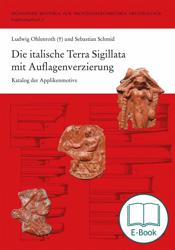Über mehrere Jahrzehnte sammelte und dokumentierte Ludwig Ohlenroth (1892–1959) italische Terra Sigillata mit Applikenverzierung aus über 100 Museen insbesondere in Deutschland und Italien. Sein unveröffentlichter Katalog umfasst über 800 Einzelmotive mit ausführlichen Beschreibungen und detaillierten Zeichnungen. Darunter finden sich teilweise extrem seltene, oft nur in Einzelstücken bekannte und bislang häufig unpublizierte Motive ebenso wie massenhaft belegte Bilder von Delfinen, Masken oder Rosetten. Auch über 60 Jahre nach Ohlenroths Tod geben seine Aufzeichnungen einen einmaligen Überblick über die Vielfalt und künstlerische Qualität der Applikenverzierung auf italischer Terra Sigillata.
Ludwig Ohlenroth, who was born in Augsburg in 1892 and died there in 1959, was not only active as an excavator and heritage conservation officer for several decades, particularly in Augsburg and Kempten, but was also intensively involved in Roman pottery. Numerous trips took him to museums in Germany and Italy, among other places, where he drew and catalogued early imperial lead-glazed vessels, Aco beakers and Sarius bowls. However, his research interest centred on Italian terra sigillata decorated with appliqués, in particular the motifs used as decoration. Ohlenroth began collecting and documenting appliqué-decorated Italian sigillata in the early 1920s. In 1937, he published an article on this ware, in which he limited himself to the examples from Raetia and Germania, but repeatedly referred to his wider research. He continued this until the 1950s, but was unable to finish it.
On more than 1200 vessels, Ohlenroth documented a total of over 900 different types of motifs, which he categorised into motif groups and described in detail. These include not only motifs frequently found on Italian terra sigillata, such as masks or heads, dogs and lions, dolphins, rosettes or various leaves, but also numerous very rare depictions, especially of a figurative nature, many of which are known only from single specimens. They give an impression of the variety and artistic quality of applied decoration on Italian terra sigillata. In addition, Ohlenroth documented the potter's stamps on the vessels and a few vessels in the form of profile drawings.
The present volume focuses on Ludwig Ohlenroth's drawings and his detailed catalogue, which had remained unnoticed for many decades as a legacy in the Bavarian State Office for Monument Protection. It is intended to serve as a reference work for the motifs of appliqué-decorated Italian terra sigillata based on a broad range of material. The legacy with the drawn motifs, edited by S. Schmid, is now supplemented by numerous new colour photographs of appliqués, in particular of rare, previously unpublished and unknown depictions. In addition, there are introductory contributions by Schmid on the life and work of Ohlenroth and the genesis of his notes on the appliqués. An extensive chapter by Schmid provides an overview of the current state of research into appliqué-decorated Italian sigillata, including chronology and production. This shows that many of the opinions expressed by Ohlenroth over eighty years ago are still valid today.
Michael Mackensen (*1949) studied Archaeology of the Roman Provinces, Prehistory and Ancient History at Munich, Freiburg and Oxford from 1969 until 1977. After his MA (1974), PhD (1977) and a travel scholarship granted by the German Archaeological Institute/DAI (1977/78) he participated in excavations of the DAI at Carthage (Tunisia) and Resafa (Syria). From 1982 to 1994 he was research assistant at the Bavarian Academy of Sciences conducting excavations in Bavaria (e. g. Nersingen, Kellmünz) and a survey project at El Mahrine (Tunisia). In 1991 he submitted his habilitation thesis and then became Professor for Archaeology of the Roman Provinces at the Ludwig-Maximilians University of Munich in 1994. He carried out various field projects in Bavaria (2001–2007 Burghöfe), Tunisia (1998/99 Chemtou), Egypt (2001/02 Deir el-Bakhît; 2005–2017 Nag al-Hagar) and Libya (2009/10 Gheriat el-Garbia, LMUexcellent-Project limes Tripolitanus). In 1989 he was allocated with the Kurt-Bittel-Preis für Süddeutsche Altertumskunde, in 2010 with the Preis für gute Lehre des Freistaats Bayern and in 2013 with the LMU Lehrinnovationspreis. In March 2015 he was retired.
Sebastian Schmid (*1982) studied Archaeology of the Roman Provinces, Ancient History and Late Antique and Byzantine History of Art in Munich, Bern and Aix-en-Provence. Following his master's thesis on the Roman fibulae from Vienna (Austria) (2009, published in 2010) and his dissertation on the Roman fort of Arelape/Pöchlarn (Austria) (2017, published in 2020), he worked as research assistant at the Department for the Archaeology of the Roman Provinces of the Ludwig-Maximilians-University of Munich. He investigated the sanctuaries of Gheriat el-Garbia (Libya) and Roman pottery from surveys in the Tripolitanian Wadi N’f’d (Gasr Isawi) and in Gheriat el-Garbia. In addition, he has published monographic studies on the Italian Terra Sigillata from Iuvavum/Salzburg (together with M. Gschwind) and Cambodunum/Kempten. He is currently working as a freelance archaeologist. His research focuses on the material culture of the Roman imperial period in the Danube region and North Africa as well as Roman military fortifications in the same areas.
Ludwig Ohlenroth (1892-1959) studied Law, Archaeology and History of Art in Munich, Erlangen and Geneva. From 1922-1932 he was employed as a curator at the Maximilianmuseum in Augsburg. He then carried out numerous excavations in Bavarian Swabia (including in Kempten, Baisweil and Schlingen) until 1940, when he was appointed the 3rd ‘Gauheimatpfleger des Gaues Schwaben’ (Heritage Officer for the District of Swabia). After the end of World War II, he was again responsible for archaeological building supervision for the city of Augsburg from 1947 until his death. In addition to his fundamental archaeological fieldwork, especially at Kempten and Augsburg, Ohlenroth was particularly interested in Roman pottery, especially Italian terra sigillata and various fine wares of the early Imperial period.


 Preface
Preface